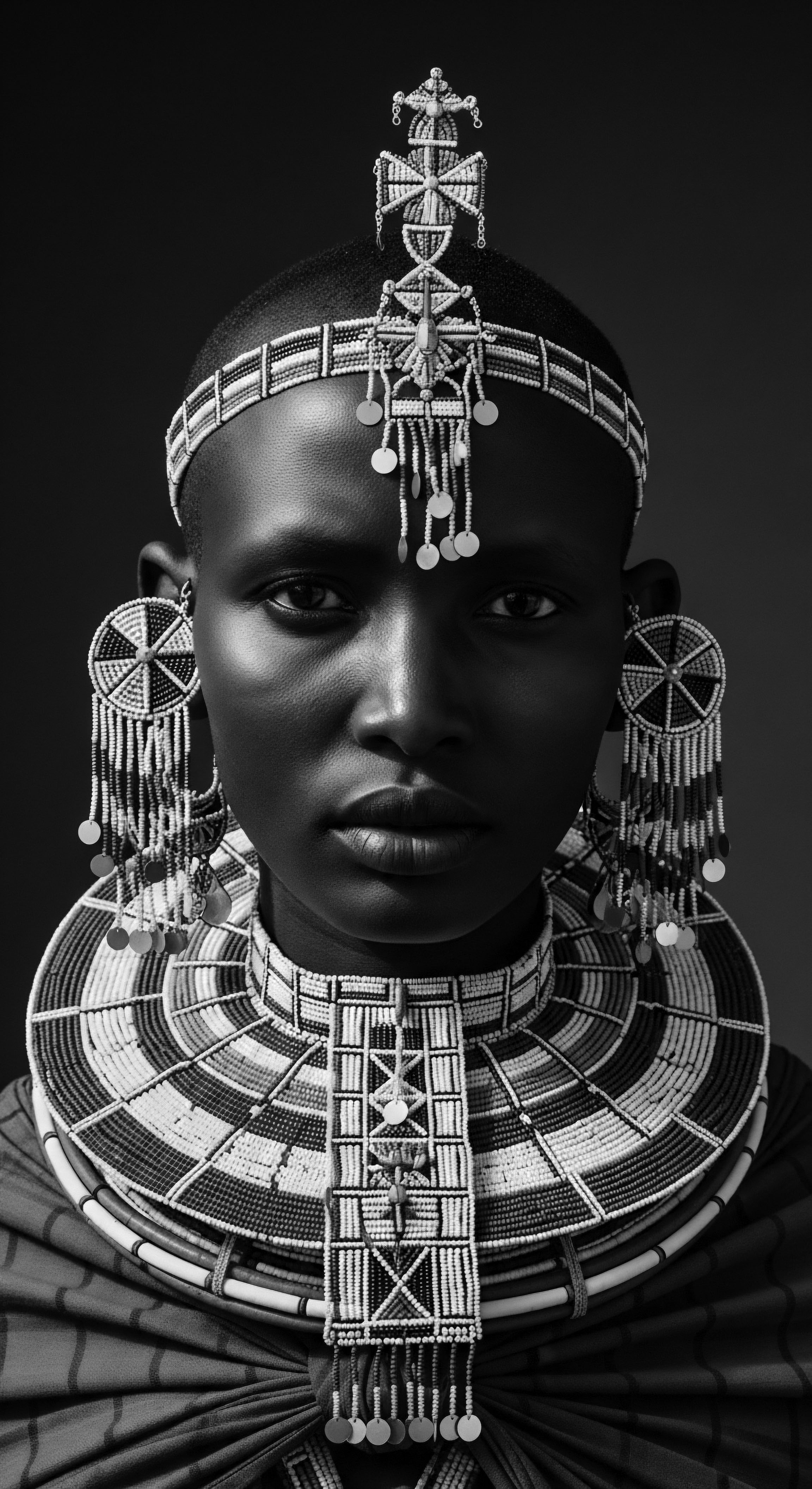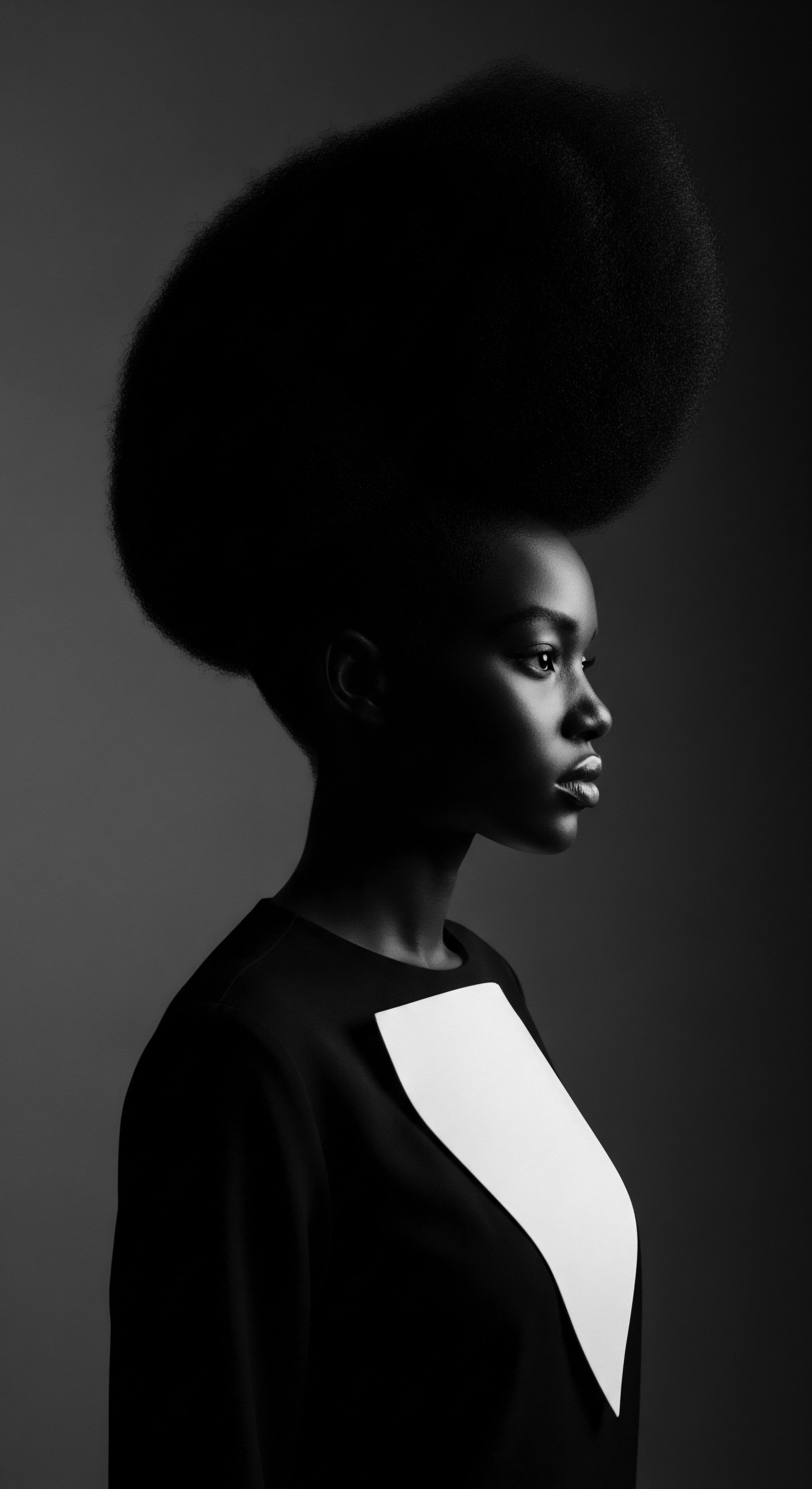
Roots
Consider, if you will, the intimate narrative written upon every curl, every coil, every wave that crowns our heads. It is a story of connection, of whispers carried across millennia, of the enduring spirit that links the ancestral to the present. To truly comprehend how the meticulous care and specialized implements of ancient Egypt shaped the textured hair heritage we claim today, we must first allow our understanding to reach back, to the very source of what hair signifies, not merely as adornment, but as a living testament to identity, status, and spiritual connection. The tools they employed were not inert objects; they were extensions of a profound relationship with self and ancestry, deeply embedded in the rich soil of Nile Valley traditions.

Hair’s Elemental Being from Ancestral Views
Our strands, in their infinite formations, speak volumes. For those with coils and curls, the helix of each fiber, its elliptical cross-section, and the intricate patterns of its cuticular scales reveal a distinct biology. This complex architecture grants textured hair its natural resilience and ability to coil, which was, and remains, a canvas for expression.
The people of ancient Egypt, whose very existence was intertwined with the rhythms of the Nile and the sun’s potent gaze, understood hair not as a mere biological outgrowth, but as a vital part of the physical and spiritual self. Their knowledge, passed down through generations, predated our modern scientific vocabulary, yet it recognized the hair’s unique qualities, perhaps through countless observations of its behavior, its response to moisture, and its tendency to gather and hold shape.
This ancient wisdom, a cornerstone of our heritage, often manifests in what we might term an intuitive science, a knowledge derived from practice and observation rather than laboratory analysis. The archaeological record, alongside textual and iconographic evidence, tells a powerful story of how these early communities cared for their hair, recognizing differences in texture.
Ancient Egyptian hair tools stand as testaments to a profound, inherited understanding of hair’s intrinsic nature.
The very concept of hair type, while often categorized in contemporary discussions with numerical and letter systems, found its own visual classification in ancient times. Observe the nuanced depictions on tomb walls and sarcophagi ❉ some figures exhibit tightly braided coiffures, others a flowing mass of curls or waves, all suggesting an appreciation for diverse hair structures. These visual archives, in their quiet way, illustrate a recognition of what we now classify as varying degrees of curl pattern or density. This visual literacy around hair, particularly for textured hair, was foundational to their grooming practices.

Ancestral Language of Hair
Within these ancient realms, a lexicon for hair, though perhaps not explicitly documented as a formal system, certainly existed through practice. The very materials chosen for hair tools, such as the use of wood or bone for combs, suggest an intuitive understanding of what would glide through hair with minimal snagging. The word choices in funerary texts or daily accounts, even when sparse, hinted at the significance of hair’s state and appearance.
- Wig ❉ A common, elaborate hairpiece, worn for hygiene, status, and aesthetic purposes, often made of human hair, vegetable fibers, or sheep’s wool.
- Braids ❉ Intricate interwoven sections of hair, widely used in both natural hair and wigs for styling and protection.
- Extensions ❉ Supplemental hair, often human hair, sheep’s wool, or plant fibers, added to natural hair to increase length or volume.
The very presence of specific tools and the styles they enabled speak to a shared understanding of hair’s capabilities.

Hair Growth Cycles and Climate’s Influence
The desert climate of ancient Egypt, with its intense sun and ever-present sand, exerted considerable influence on hair health and care practices. This harsh environment prompted a deep concern for scalp protection and hygiene. Wigs, for instance, offered a layer of defense against solar radiation and were used as a hygienic measure against lice and other pests.
This environmental pressure shaped their approach to hair health, pushing them towards methods that preserved and protected. The understanding of growth cycles, though not scientifically articulated as we do today, would have been apparent through the observation of hair shedding and regrowth, influencing the maintenance of wigs and natural hair.
Consider the evidence ❉ fine-toothed combs, crafted from materials like ivory and wood, were practical tools used for removing lice and their eggs. The existence of such implements speaks to a societal awareness of hygienic needs. This daily engagement with hair, in its entirety, was not merely about outward appearance; it was about well-being, about maintaining a balance with the environment, a practice that echoes in holistic textured hair care today.

Ritual
The relationship between ancient Egyptian hair tools and textured hair heritage unfolds in the meticulous rituals of styling and transformation. These practices were not fleeting trends; they were deeply rooted in a cultural context where hair served as a potent symbol of status, cleanliness, and divine connection. The tools themselves, from the simplest comb to the sophisticated curling tong, were instruments of this daily, often ceremonial, engagement with one’s crowning glory.

Tools for Sculpting and Maintaining Textured Hair
Ancient Egyptians employed a remarkable array of tools, many of which find echoes in our contemporary textured hair routines. Combs, perhaps the most fundamental of all, were crafted from various materials, including wood , bone , and ivory . These combs often featured wide gaps between teeth, a detail that suggests a practical consideration for managing hair that might be prone to tangling, such as textured hair. Their presence in tombs as burial offerings underscores their profound importance in life and the afterlife.
Archaeological finds confirm the use of specialized implements. Curling tongs, for instance, were used to create tight ringlets, a fashionable look for both men and women. This speaks to a deliberate manipulation of hair texture, accentuating its natural curl or creating desired patterns. Razors, made from stone, copper, or bronze, were also utilized for shaving heads or cutting hair short, often for hygiene or in preparation for wearing wigs.
Ancient Egyptian tools provided the means to sculpt hair into culturally significant forms, from intricate braids to voluminous wigs.
The materials selected for these tools were also significant. Ivory combs, often exquisitely carved with animal motifs like gazelles, were luxury items, signifying social standing and refinement. These items were not merely functional; they were works of art, reflecting the artisan’s skill and the owner’s wealth. The continuity of such tools, in their various forms, across millennia, truly connects us to an enduring heritage of hair care.

Styling Techniques ❉ Braids, Wigs, and Extensions
The array of hairstyles depicted in ancient Egyptian art reveals a mastery of techniques particularly relevant to textured hair. Braiding was a common practice, both for natural hair and for creating elaborate wigs. Mummified remains often showcase intricate braids, testifying to the skill of ancient hairdressers. These braids served both aesthetic and practical purposes, providing a protective style against the harsh climate and maintaining hair neatness.
Wigs were a central element of ancient Egyptian hair culture, worn by both men and women across social strata, from the elite to the common populace. They offered protection from the sun, served hygienic purposes by preventing lice, and allowed for diverse styling. Wigs were often made from human hair, plant fibers, or sheep’s wool, and attached using natural adhesives like beeswax. The sheer variety of wig designs, from short bobs to long, elaborate styles with multiple curly braids, showcases the ingenuity and artistry of ancient Egyptian hair professionals.
The use of hair extensions dates back to at least 3400 BC in ancient Egypt. These were added to natural hair to create desired thickness or length, or to conceal thinning areas. Cleopatra, for instance, is often linked to striking blue hair extensions, a testament to the vibrant and expressive nature of these hair enhancements. This early adoption of extensions for volume and artistry finds a strong parallel in modern textured hair styling, where extensions continue to offer versatility and creative freedom.
A remarkable example of ancient Egyptian hair artistry, directly relating to textured hair heritage, is the discovery of a wig and braided hair extensions in the tomb of Merit, the wife of architect Kha, at Deir el-Medina. This particular wig consisted of numerous curly braids of dark brown hair, and alongside it, a small box containing braided hair extensions was also found. This archaeological evidence confirms the sophisticated techniques used to craft these pieces and highlights the value placed on hair volume and elaborate styles.
The fact that Hatnofer, mother of Queen Hatshepsut’s architect Senenmut, also wore similar braids, arranged in thick masses to create a voluminous, curly style associated with the goddess Hathor, further underscores the cultural significance of these elaborate textured styles and the tools used to create them. This specific instance illustrates not only the practical application of tools to shape hair, but also the deep symbolic meaning woven into the strands, linking hair, identity, and even divinity.
| Tool Category Combs |
| Common Materials Wood, bone, ivory |
| Primary Use for Hair Detangling, styling, hygiene, lice removal |
| Tool Category Curling Tongs |
| Common Materials Metal (speculative based on function) |
| Primary Use for Hair Creating tight ringlets and waves |
| Tool Category Razors |
| Common Materials Stone, copper, bronze |
| Primary Use for Hair Shaving heads, cutting hair short for wig wearing |
| Tool Category Wig/Extension Components |
| Common Materials Human hair, sheep's wool, plant fibers, beeswax |
| Primary Use for Hair Constructing elaborate wigs and adding hair length/volume |
| Tool Category These tools enabled both aesthetic expression and practical hygiene, reflecting the ancient Egyptians' sophisticated approach to hair. |

How Did Ancient Egyptian Hair Tools Facilitate Hair Protection and Hygiene?
The tools of ancient Egypt were instrumental in maintaining optimal hair and scalp hygiene, a practice of paramount importance in their hot, arid climate. Combs, particularly those with finer teeth, served a crucial role in managing head lice, a common concern in ancient societies. The discovery of an ivory comb from around 1700 BCE inscribed with a plea against lice—”May this tusk root out the lice of the hair and the beard”—highlights the pervasive nature of this issue and the direct utility of these tools in addressing it. This historical evidence firmly connects ancient hair tools not just to aesthetics, but to the practicalities of public health and individual comfort.
Beyond lice removal, wigs themselves, often worn over shaved or closely cropped natural hair, served as a protective barrier from the intense sun. This shows an understanding of environmental factors impacting hair health, a protective wisdom that resonates with contemporary practices in textured hair care. The ability to remove wigs for cleaning or airing also contributed to overall hygiene. This holistic approach, where tools served both beauty and wellness, underscores a deep respect for the body and its well-being, an ancestral wisdom deeply woven into the fabric of textured hair heritage.

Relay
From the fertile banks of the Nile, the practices and preferences shaped by ancient Egyptian hair tools have flowed through time, influencing and mirroring the vibrant tapestry of textured hair heritage. This enduring legacy is not merely a collection of preserved artifacts; it is a living tradition, a testament to ingenuity and a profound connection to self. The interplay between ancestral care philosophies and the tangible tools they employed offers a powerful lens through which to comprehend the resilience and adaptability of Black and mixed-race hair practices across generations.

Ancestral Wellness Philosophies and Hair
Ancient Egyptian hair care transcended mere cosmetic application. It was an integral component of holistic wellness, deeply intertwined with notions of cleanliness, status, and spiritual purity. The meticulous nature of their hair practices, from elaborate styling to the regular use of conditioning oils and balms, points to a comprehensive understanding of hair health.
For instance, the use of beeswax and perfumed oils to set wigs and style natural hair suggests an awareness of moisture retention and conditioning. This ancestral focus on nurturing the hair, providing it with protective environments and enriching substances, forms a foundational layer of our textured hair heritage.
The emphasis on hygiene, particularly through shaving and wig-wearing to mitigate lice, highlights a proactive approach to well-being that prioritized comfort and communal health. Priests, for example, often shaved their heads to maintain ritual purity, demonstrating how hair practices were deeply embedded in societal and spiritual frameworks. This practical wisdom, born from lived experience and environmental necessity, offers a compelling parallel to modern textured hair care, where protective styles and conscious product choices shield strands from environmental stressors.
The wisdom embedded in ancient Egyptian hair tools extends to a holistic approach, linking physical care with societal and spiritual well-being.

How Did Ancient Egyptian Hair Tools Symbolize Status and Identity?
The tools and their resulting hairstyles were powerful symbols of social standing and individual identity in ancient Egypt. Combs, especially those crafted from luxurious ivory or adorned with intricate carvings, transcended their utilitarian function to become indicators of wealth and artistry. Wigs, in particular, were visual signals of one’s position within society; the more elaborate and finely made the wig, the higher the status of the wearer. Pharaohs and queens often sported the most opulent wigs, underscoring their divine authority.
This visual language of hair allowed for nuanced communication within their society. The choice to wear a wig, or to adopt a particular style, communicated not only social standing but also adherence to cultural norms and aesthetic ideals. This symbolic weight carried by hair, and the tools used to shape it, is a profound aspect of textured hair heritage, where hair continues to serve as a powerful marker of identity, cultural pride, and personal expression, often against a backdrop of historical and contemporary pressures.

Ancestral Practices and Contemporary Resonance
The continuity between ancient Egyptian practices and contemporary textured hair care is striking. The ancient Egyptians’ reliance on braids for protection and styling, for example, directly foreshadows the widespread use of protective styles like braids, twists, and locs in Black and mixed-race communities today. Both historical and modern practices recognize the benefits of keeping textured hair neatly contained, reducing manipulation, and minimizing environmental exposure.
Moreover, the very presence of tools like “afro picks” in ancient Egyptian tombs, as noted by some scholars, points to a continuous lineage of managing and styling textured hair. While direct evidence for ‘afro picks’ in the modern sense might be subject to interpretive nuance, the existence of combs with wider gaps between teeth suggests tools suited for hair with greater density and curl, a common characteristic of textured hair. (Lucas & Harris, 1962, p. 150) This connection provides a tangible link across thousands of years, demonstrating a shared understanding of hair’s needs and the ingenuity required to meet them.
| Ancient Egyptian Practice Wig Wearing for Protection |
| Contemporary Textured Hair Heritage Connection Protective styles (wigs, weaves, braids) that shield natural hair from elements and manipulation. |
| Underlying Principle Minimize environmental stress and reduce hair breakage. |
| Ancient Egyptian Practice Use of Oils and Balms |
| Contemporary Textured Hair Heritage Connection Emphasis on moisturizing and sealing with natural oils (e.g. shea butter, coconut oil). |
| Underlying Principle Maintain moisture balance and enhance hair suppleness. |
| Ancient Egyptian Practice Combs for Detangling and Hygiene |
| Contemporary Textured Hair Heritage Connection Wide-tooth combs and fingers for gentle detangling, regular cleansing for scalp health. |
| Underlying Principle Prevent damage and promote a healthy scalp environment. |
| Ancient Egyptian Practice Braiding for Structure and Style |
| Contemporary Textured Hair Heritage Connection Prevalence of braids, twists, and locs for style, growth retention, and cultural expression. |
| Underlying Principle Manageability, length retention, and cultural identity. |
| Ancient Egyptian Practice The enduring wisdom of ancient Egyptian hair care continues to shape the strategies and practices of textured hair communities today. |
The enduring significance of head coverings, from ancient wigs to modern bonnets and wraps, also speaks to a continuous thread of protective wisdom. The practice of covering hair, whether for hygiene, adornment, or preservation, transcends specific eras. It manifests as a deep-seated respect for hair’s vulnerability and its inherent need for protection, a heritage passed down through generations.

Reflection
When we observe the combs of wood and ivory, the remnants of human hair woven into ancient wigs, and the depictions of elaborate coiffures on tomb walls, we are not simply looking at historical artifacts. We are witnessing the tangible echoes of an ancient civilization’s profound connection to its textured hair. These tools, once held in ancestral hands, shaped more than mere styles; they helped define an entire heritage, contributing to a legacy of beauty, hygiene, and identity that flows through Black and mixed-race hair traditions today. The Soul of a Strand, truly, lives within these enduring connections, a testament to an ancestral wisdom that persists, inviting us to honor our coils, curls, and waves as living archives of resilience and self-expression.

References
- Fletcher, J. O. (2004). Egyptian Hair ❉ Hairdressing, Wigs and Hair Extensions. In A. Lucas, & J. R. Harris, Ancient Egyptian Materials and Industries (4th ed. pp. 495-500). Edward Arnold.
- Lucas, A. & Harris, J. R. (1962). Ancient Egyptian Materials and Industries (4th ed.). Edward Arnold.
- Nicholson, P. T. & Shaw, I. (Eds.). (2000). Ancient Egyptian Materials and Technology. Cambridge University Press.
- Robins, G. (1994). Proportion and Style in Ancient Egyptian Art. University of Texas Press.
- Teeter, E. (2011). Religion and Ritual in Ancient Egypt. Cambridge University Press.
- Walker, M. (1998). The Cultural History of Hair. Routledge.
